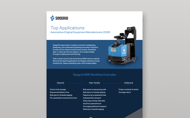The automotive industry in the United States has been in constant flux due to the COVID-19 outbreak. Over the course of the second quarter in 2020, the pandemic caused many automotive companies to virtually shut down.
With consumers facing very unpredictable and uncertain circumstances, auto sales halted to a standstill, and many automotive companies posted record low margins and net losses for sales. The extreme shift in consumer demand was met with new safety guidelines, higher than normal work absence rates, and shrinking labor pools for manufacturing facilities. With so many unforeseen hurdles, companies were left wondering how to operate efficiently and safely with less people.
Fast forward to the third quarter of 2020, and it quickly became a completely different story. Many of these same automotive companies that were forced into facility shutdowns began reporting record setting profits, on track to exceed pre-pandemic sales levels for new vehicles. To meet these extremely high levels of demand and efficiently fulfill orders, automakers are continuing to work at full speed while trying to combat major challenges. This positive spike in demand adds pressure for manufacturing facilities to produce products faster and more efficiently while operating with a limited workforce and maintaining a safe working environment that is compliant with new social distancing measures.
One thing that is certain is that change will always be a factor. Challenges will continue to evolve over time, even outside of a global pandemic. Regardless of the root cause, changes in demand, consumer preferences, product offerings, accessibility to supplies, and available human labor are inevitable and will always be on a moving scale. COVID-19 put a bright spotlight on the hurdles supply chains face, which is why so many companies quickly turned to automation solutions. In fact, Peerless Research Group conducted a survey* in which 89% indicated that their company’s plans to purchase robotics solutions accelerated as a result of changes to their supply chain caused by COVID-19.
Achieve Maximum Productivity with Flexible Material Handling Automation
When selecting a material handling automation partner, it is imperative to find a solution that is flexible. Look for solutions that allow you to easily make changes without costing production downtime, facility reconstruction, or additional support charges. Simply put, select, implement, and scale with a solution that can accommodate for changes.
For example, Seegrid Palion autonomous mobile robots (AMRs) are designed for flexibility. The AMRs can easily be retrained in-house by facility employees without assistance from a Seegrid representative. If workflows, demands, or needs change at any time, Palion AMRs can quickly be redeployed to new routes, tasks, or different facilities all together. To change a workflow, a facility employee can simply drive the Palion AMR on the new route. The autonomous tow tractor or pallet truck is then ready to take on its new task. Once robots are trained, the routes can also be shared across the fleet, saving extensive downtime.
Due to the pandemic, many automotive manufacturers experienced a sudden spike in employee absences. Without AMRs and AGVs in place, facilities were scrambling to find additional help amongst a limited labor pool and changing workflows to operate with less people. As many discovered, this wasn’t sustainable, safe, or productive. However, with AMR technology in place, a facility could instantly dispatch a robot to perform the new tasks at hand. The labor shortage for skilled laborers has only grown since the start of the pandemic, leaving facilities with low shift counts. The need to operate efficiently with less people is not only critical for today, but also a necessity for continued success in the future.
Ensure Employee Safety with AMRs and AGVs
Never compromise on safety. The safety and wellbeing of employees should always be the number one priority in any facility. When demands and challenges escalated due to the pandemic, the notion of safety took on additional meaning.
Pre-pandemic, the focus for safety in manufacturing facilities was on reducing the risk of injury around industrial equipment and long-term ergonomic concerns. These risks still apply today, with OSHA estimating nearly 100,000 manual forklift accidents each year. The Centers for Disease Control and Prevention (CDC) reported 22% of work-related deaths were due to forklift overturns, and 20% were due to a pedestrian being struck by a manual forklift. Manually driven forklifts are inherently dangerous, and can cause costly losses for a company, including damaged products and equipment, employee injuries, or even fatalities.
Safety is driving momentum for forklift-free environments. Seegrid Palion AMRs autonomously move billions of pounds of materials each month and have safely driven millions of autonomous miles in real production facilities. This is because Palion AMRs go above and beyond ANSI B56.5 safety standards, working seamlessly and safely alongside their human coworkers. Palion AMRs always follow the rules and mitigate the risk of relying on human input. With technology in control, the robot will reliably follow the intended route, maintain speed limits, avoid collisions, behave predictably and consistently, and never behave erratically.
Independent UL approved safety systems are built into Palion AMRs to ensure safe operation around machinery and personnel. Seegrid’s approach is to not only meet, but to also exceed regulatory requirements by building an envelope of constantly scanning safety sensors to ensure the robot will stop before contacting any obstructions, including people.
COVID-19 posed yet even more safety challenges in terms of public health. With regulatory social distancing measures implemented overnight, facilities needed to restructure workflows to keep employees working safely while mitigating the spread of COVID with less in-person interactions. At a customer’s facility, Seegrid AMRs allowed for a 50% reduction in operator touches over the course of one shift by automating payload exchanges. Additionally, it allowed for a 100% decrease in direct contact between associates working in different functional areas. Not only do Palion AMRs mitigate production challenges caused by labor shortages, but they also increase safety for all employees by facilitating new safety guidelines and reliably following orders with automated processes.
Continue to Drive Material Flow Efficiencies and Scale Your Success
There no longer has to be a tradeoff between safety and productivity. Achieve both goals and confidently continue to optimize for an even stronger tomorrow. Understand that change will always be a factor. Not only should a facility plan for changes in operational demands, but facilities should also plan on their operation evolving and becoming more efficient over time.
As facility employees see the value of AMRs and how autonomous vehicles help them achieve their goals, employees will become comfortable working alongside the robots and automation adoption will soar. This is why a flexible solution is so important. AMRs are designed to increase productivity, safety, and efficiencies, while reducing operating costs. As Industry 4.0 initiatives are achieved and productivity is boosted, a facility should continue improving by scaling the implemented industrial automation technologies.
Automation solutions are an investment, which is why a company should find a solution that can evolve with their needs. When planning automation initiatives, look at the big picture. Avoid only solving short-term goals — select an automation partner that provides the technology that enables a facility to continue improving, even beyond today’s needs. Ultimately, to ensure a successful operation despite any disruptions, implement an automation solution that is flexible, increases safety, and can scale to meet today’s needs as well as any needs in the future.
*Peerless Research Group. (August 2020). Robotics in the Age of COVID-19 Report.

|
INFOGRAPHIC Discover how Seegrid AMRs are helping Automotive OEMS streamline workflow to boost productivity, reduce costs, and increase safety. |








